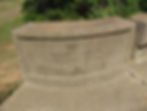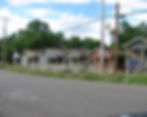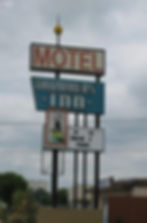The Dixie Overland / Bankhead Highway, aka US 80
- Robin Cole-Jett
- Sep 15, 2023
- 10 min read

Highway 80 is not the mythical road that US 66 is, and it hasn't been dubbed anything interesting like the "Lincoln Highway," which is what travelers call US 50. Nor does it go through some of the first settlements in the United States, from Florida to Maine, like US 1 does. Still, US 80 - formerly known as the Dixie Overland Highway that merges with the Bankhead Highway in Dallas and westward - is the mother road of the Red River Valley.
Running from Tybee Island, Georgia to San Diego, California, the Dixie-Overland Highway / US 80 spans the southern portion of the United States, passing through Alabama, Mississippi, Louisiana, Texas, New Mexico, and Arizona along the way. If you took it from end to end, you'd travel almost 2,500 miles, and according to Google Maps, it would take you at least 3 days.
For this article, I won't be taking you all the way through. Concentrating on the areas around the Red River, let's instead take a road trip from Louisiana to parts of western Texas on this old highway. I'm also going to show you the high-lights of the trip (meaning "the places for which I have photos").
Like US 66, US 80 has been decommissioned west of Mesquite, Texas. It has merged in many places with Interstates 20 and 30 (further west, with Interstate 10). Mostly, though, the interstate can be avoided through careful planning!
LOUISIANA
Arcadia
Let's start in Arcadia, known as the town that witnessed the after-life moments for Clyde Barrow and Bonnie Parker, who died in a hail of bullets southwest of town in May of 1934. Photographs and newsreels of the outlaw lovers on the slab circulated throughout the country; the morgue was actually the town's furniture store, now gone. Follow US 80 west through town as 1st Street and then, 2nd street.
The original alignment for the Dixie-Overland Highway is via Parish Road 260, which turns into Grover Jones Road towards Gibsland. There are just thick forests in this stretch of road, not much to see.
Gibsland
Just south of Gibsland on LA 154 near Mount Lebanon, Bonnie and Clyde met their ends by a posse of law enforcement officers. Gibsland's museum is dedicated to the pair, housed inside the former cafe where Bonnie at her final sandwich. Every May, the town holds a Bonnie and Clyde festival, complete with reenactments. More impressively, Gibsland is a former college town, where Coleman College operated for African American students until the 1940s. The site of the college is now Gibsland's Coleman High School.
Minden
Us 80 enters Minden as a single US highway and leaves Minden by sharing the street with US 79. Minden, a quaint city founded by a German gold-rush seeker, demonstrates its German roots by its orderly, vibrant downtown.
Bossier City
Upon entering Bossier City as you head west, you'll pass through Red Chute, named after a creek that feeds into the Red River and also the namesake of a former plantation. Before the US 80 was a federal highway, let alone the Dixie Overland highway, it was Shed Road through Bossier City. Bossier City lies pretty much in a flood plain, and the road to Red River was mired in muck. Building a several-mile shed over the road helped keep animals and wagons from sinking in the mud. Modern pavement made the shed obsolete, but the original alignment is still there as Shed Road. Shed Road runs parallel to US 80, aka Texas Street.
Shreveport
The Dixie Overland Highway entered into the first real metropolis along the Red River as Texas Street, an ancient Caddo trace and then, a migrant road for people trying to get to Texas for reasons only known to them and perhaps the law. Har har!
Texas Street was once the major artery of Shreveport, and while Interstate 20 allows travelers to bypass the city, connoisseurs of good road trips know to take the "bona fide" instead. Texas Street passes iconic places like the Shreveport Municipal Auditorium, former home to the Louisiana Hayride radio program; Oakland Cemetery with its yellow fever victim mound; the State Fair grounds; and the former neighborhood of St. Paul Bottom, a legendary vice district known for its jazz and blues, juke joints, and brothels.
This section of town is only a shadow of its former self, however. The many businesses along Texas Street are shuttered save for legendary Herbie K's Restaurant. The shot gun houses that created a vibrant urban density are mostly gone, and the Italian neighborhood, still home to Fertitta's Delicatessen, is almost completely demolished. Texas Street's demise is testament to what happens when cities allow Interstates to cut through town without proper planning. How the city council and parish commission allowed this happen is still beyond me.
Greenwood
When driving US 80 west of town, you'll sometimes feel that you need to merge with Interstate 20, but try to avoid this by following the frontage/service road and when you can, Greenwood Avenue, instead. Before leaving Shreveport, though, take a quick jaunt south on US 171/Hearne Avenue. At the intersection with Kings Highway is an original location of Southern Maid Donuts, a home-grown Shreveport treat (okay, imported via Houston, but the first franchisee!).
Before entering Texas, you'll pass through the old town of Greenwood but you wouldn't know it; most of Greenwood sports newer buildings, including massive truck stops. The interstate also cut Greenwood off from its own cemetery, which sits north I20 while the town is south.
Between Shreveport and Greenwood off West 70th Street is the "Pea Farm," an abandoned state penitentiary that is off-limits save for intrepid urban explorers. During its life, which began in 1905, it was the county's penal farm. This means that the facility has marked and unmarked graves on the site.
TEXAS
Marshall & Longview
Follow US 80 into Marshall, where it is known as Victory Drive. On the way, you'll drive past Waskom.
US 80 now is a straight, four lane road that divides downtown Marshall from its historic depot. Marshall's courthouse is definitely worth a visit, as it hosts a really interesting museum, and the historic train depot welcomes Amtrak's Texas Eagle, which makes daily runs between San Antonio and Chicago. From Marshall westward, US 80 parallels the route for the last interstate passenger train in Texas (as of right now).
After passing through a few smaller towns, you'll get to Longview but US 80 bypasses its downtown, too. But you can take the earlier alignment through downtown on Whaley Street if you'd like.
Gladewater, Big Sandy, Mineloa, Grand Saline, Terral, et. al.
Along US 80 are several towns that boast to be "antique capitals." They are all quite picturesque. Grand Saline, once home to an underground salt mine, even has a house made entirely of salt blocks. Go take a lick!
Soon, you'll make your way into Dallas, where US 80 becomes a freeway. Now you'll need some real direction as here, the Dixie Overland Highway becomes the Bankhead Highway (east of Dallas, the Bankhead Highway's alignment is US 67).
Dallas
Once in Dallas, you'll be following a lot of roads that were once US 80. Since the "official" US 80 consists now of Interstate 30, I'm consulting an old Conoco Map for your jaunt through Dallas and later, Fort Worth. Today, the old US 80 route through Dallas is unmarked.
When you pass by Interstate 635 on US 80, you'll want to take the exit for Town East Boulevard, go south, and then start driving on Samuell Boulevard.
Keep on Samuell Boulevard (which used to be called East Pike during US 80's hey-day) until you reach East Grand Avenue/ TX 78. To follow old US 80, turn left onto Grand Avenue/ TX 78 until it meets Haskell Avenue. You'll be in the heart of the Fair Park neighborhood on this route, and you'll catch glimpses of the Cotton Bowl as you mosey on towards downtown. As soon as you turn onto TX 78, you'll be on the Bankhead Highway, an old route that linked Washington D.C. to San Diego.
Turn right onto Haskell and follow it west. Quite quickly, Haskell will become Stonewall Street, as s and Haskell splits into two one-ways. At the intersection of Stonewall and Parry Avenue, turn left. Parry Avenue will take you right by Fair Park!
After you cross the DART light passenger rail tracks, turn right onto Commerce Street and follow it into downtown Dallas through the famous Deep Ellum neighborhood. At the intersection of Parry and Commerce is a grand old fire station, which has been converted into a museum.
As you drive up Commerce, you'll have to jog onto Main Street or Elm Street to your right, as Commerce becomes a one way street in the opposite direction. To get to Main or Elm Streets, take Exposition to the right and then turn left onto either Main or Elm (both will take you through downtown). Commerce Street is the original US 80, however.
Commerce, Main, and Elm Streets form the center roads for downtown Dallas. All three merge on the west side of downtown into Commerce Street as they pass through the infamous "Triple Underpass." If you drive down Elm Street, you'll see the "X" on the road that marks where John F. Kennedy was shot.
After they merge, Commerce Street becomes a two-way road. This portion of Commerce street is a newer alignment of US 80, which locals still call the "Fort Worth Turn Pike." You can follow this road directly to Fort Worth. Clyde Barrow is buried just off this road in the Western Heights Cemetery, about a mile west of the Trinity River between Navarro and Neal Streets.
If you want to follow the original alignment of the Dixie-Overland/Bankhead Highway aka US 80, you'll have to turn left onto Houston Street at Dealy Plaza. Follow Houston Street as it curves onto the Houston Street Viaduct, considered the longest concrete bridge in the world (and who'd want to dispute that!)
Interesting side note: the Trinity River used to flow where the Triple Underpass now stands. The river was straightened through a series of dikes by levees in the late 1910s. This project was considered one of the most expensive and ambitious civic undertakings in US history. The reclaimed land became the Interstate 35E and River Front Boulevard nee Industrial Boulevard thoroughfares.
Oak Cliff
If you took the older alignment from Houston Street, your path will lead you through the heart of Oak Cliff on Jefferson Boulevard, which passes by the Texas Theater, where Lee Harvey Oswald was arrested after his event-filled day in November of 1963. An even earlier alignment is Davis Street just to the north. Davis and Jefferson boulevards parallel each other, but Davis is now officially US 80, or actually US 180 because the US 80 designation west of Dallas has been decommissioned.
Fort Worth Avenue will merge with Davis Street just west of Westmoreland Road, and you'll once again follow a single US 80, which is now designated as TX 180.
Grand Prairie
Once you pass over Loop 12, you'll be in Grand Prairie. There's not much to see here, except some old drive-ins and several flea markets. TX 180/ US 80 becomes Main Street in Grand Prairie.
Arlington
Continue west on TX 180 / US 80. After the intersection with Great Southwest Parkway, you'll be in Arlington, the third largest city in the Dallas/ Fort Worth Metro-area. Long before you get to Arlington, however, you'll be able to see its newest landmark: the brand new Dallas Cowboys Stadium, a.k.a. the Jerry-dome. It is HUGE. It also occupies an older section of town that had been condemned through eminent domain to make way for the stadium. The many diners, motels, and older stores from the old neighborhood that still ring the stadium will
most likely go away soon, as developers see opportunity knocking.
In Arlington, TX 180/ US 80 becomes Division Street. This a cool old road that is hugged by down-home restaurants, dance halls, and local dives. The large campus of the University of Texas at Arlington sits behind this street, next to the rather nondescript downtown.
West of downtown is one of my favorite spots on this jaunt: Arlington Baptist College. But not because I'm religious — it's because the campus, built of sand stone and situated on one of the highest hills in Tarrant County, sits on the site of a former speakeasy, the Top of the Hill Terrace. Drinkers and gamblers would revel in an underground tavern, but would flee through an underground tunnel if the police showed up. Yes, OF COURSE Bonnie and Clyde were spotted here.
Fort Worth
As you come down this way, you'll pass through Handley, a small railroad town that maintains its identity separate from Fort Worth.
In Fort Worth, TX 180/US 80 becomes Lancaster Avenue. It doesn't go through the best of neighborhoods - several homeless missions line the road on both sides. When you pass under the Interstates near downtown, you'll see why Lancaster Avenue had a more seedy side to it... it used to empty right into the heart of the notorious Hell's Half Acre. Alas, the convention center has replaced this storied neighborhood.
According to my trusty Conoco Map, the old US 80 route veered off from Lancaster Avenue and onto Main Street. Then, it continued west on 7th Street, and then followed Camp Bowie Boulevard to the southwest. You can jog this path, or just stay on Lancaster Avenue until it intersects with Camp Bowie Boulevard - the choice is yours. Both ways are interesting.
Camp Bowie Boulevard (also US 377) is Fort Worth's favorite road. It's bumpy, too, as some of its sections remain paved with brick. The Modern Art Museum, the Kimball, and the Museum of Science and History are located off of Camp Bowie, and many stores, restaurants, and theaters line the road, too. The neighborhood surrounding Camp Bowie is quite eclectic, ranging from old apartment buildings to 1950s suburban homes to fancier digs. Camp Bowie Boulevard is the reason why so many people fall in love with Fort Worth.
Once Camp Bowie Boulevard passes underneath Interstate 30, it becomes the current US 80. You'll want to follow the signs for US 80 - that means, veer right to stay on Camp Bowie Boulevard, and follow the street as it becomes Palo Pinto Drive. You'll eventually have to merge with Interstate 30 to go west.
Weatherford, Mineral Wells, and beyond
Exit the interstate onto TX 180/ Fort Worth Highway in Weatherford and continue on US 180 - the old Bankhead Highway - westward. Along the way, you will find some of the old alignments from the 1920s, which I've detailed in the images below.
US 80 is one of the grande-dames of the American highway system. While it still exists as a supplemental road to Interstates 30, 20, and 10, traces and swaths of the old road - and the automobile culture that went along with it - still remain. Like Route 66 and US 50 have done for their states, this highway has defined the Red River Valley, and I hope that one day, just like its sisters, its importance will be recognized.














